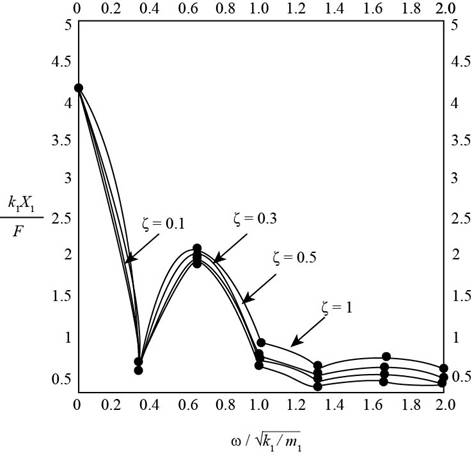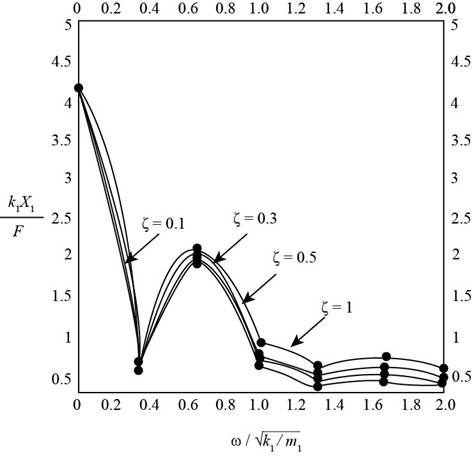
Concept explainers
(a)
The expression for
The expression for
Answer to Problem 13.23P
The expression for
The expression for
Explanation of Solution
Given information:
The main mass is
Write the expression for force of mass 1.
Here, mass of body 1 is
Write the expression for absorber mass.
Here, mass of the absorber is
Apply Laplace transform on Equation (I).
Take Laplace transform of equation (II).
Apply Cramer rule in Equation (III) and (IV).
Further solve Equation (V).
Write the expression for parameter
Write the expression for parameter
Write the expression for parameter
Write the expression for parameter
Here, angular speed of main mass is
Write the expression for parameter
Write the expression for parameter
Write the expression for parameter
Substitute
Substitute
Apply Cramer rule for Equation (VI) to obtain
Apply Cramer rule for Equation (VI) to obtain
Write the expression for
Substitute
Substitute
Substitute
Substitute
Write the expression for
Substitute
Substitute
Solve Equation (XV) and (XXV).
Substitute
Conclusion:
The expression for
The expression for
(b)
The plot between
Answer to Problem 13.23P
The plot between
Explanation of Solution
Given information:
The main mass is
To plot the graph, consider some constant values such as
Calculation:
Substitute
Substitute
Substitute
Substitute
Substitute
Assume
Substitute
Substitute
Substitute
Prepare a table for various value of
The figure below shows the plot between

Figure-(1)
Conclusion:
The plot between

Figure-(1).
Want to see more full solutions like this?
Chapter 13 Solutions
System Dynamics
 Elements Of ElectromagneticsMechanical EngineeringISBN:9780190698614Author:Sadiku, Matthew N. O.Publisher:Oxford University Press
Elements Of ElectromagneticsMechanical EngineeringISBN:9780190698614Author:Sadiku, Matthew N. O.Publisher:Oxford University Press Mechanics of Materials (10th Edition)Mechanical EngineeringISBN:9780134319650Author:Russell C. HibbelerPublisher:PEARSON
Mechanics of Materials (10th Edition)Mechanical EngineeringISBN:9780134319650Author:Russell C. HibbelerPublisher:PEARSON Thermodynamics: An Engineering ApproachMechanical EngineeringISBN:9781259822674Author:Yunus A. Cengel Dr., Michael A. BolesPublisher:McGraw-Hill Education
Thermodynamics: An Engineering ApproachMechanical EngineeringISBN:9781259822674Author:Yunus A. Cengel Dr., Michael A. BolesPublisher:McGraw-Hill Education Control Systems EngineeringMechanical EngineeringISBN:9781118170519Author:Norman S. NisePublisher:WILEY
Control Systems EngineeringMechanical EngineeringISBN:9781118170519Author:Norman S. NisePublisher:WILEY Mechanics of Materials (MindTap Course List)Mechanical EngineeringISBN:9781337093347Author:Barry J. Goodno, James M. GerePublisher:Cengage Learning
Mechanics of Materials (MindTap Course List)Mechanical EngineeringISBN:9781337093347Author:Barry J. Goodno, James M. GerePublisher:Cengage Learning Engineering Mechanics: StaticsMechanical EngineeringISBN:9781118807330Author:James L. Meriam, L. G. Kraige, J. N. BoltonPublisher:WILEY
Engineering Mechanics: StaticsMechanical EngineeringISBN:9781118807330Author:James L. Meriam, L. G. Kraige, J. N. BoltonPublisher:WILEY





